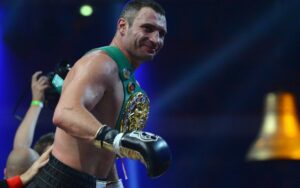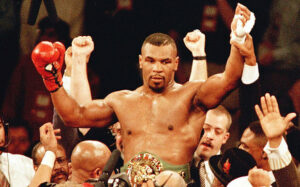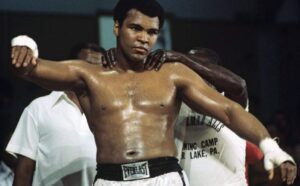When Tyson Fury faces WBC heavyweight world champion Deontay Wilder this Saturday, he will be attempting to join a select group of boxers who have lost and regained the heavyweight championship after a significant lay-off from boxing, in circumstances ranging from heroic to inglorious. In this article, we take a look back at four men who – for good or for bad and whether by dint of their own choice or the intervention of fate – took a prolonged leave of absence from the boxing ring and returned with a vengeance.

#4 Vitali Klitschko
After successfully defending his WBC heavyweight title against Danny Williams in December 2004, Vitali Klitschko did not fight again for nearly four years, officially retiring in 2005 due to a series of injuries suffered in training. The WBC awarded him the status of ‘Emeritus Champion’, giving him the immediate right to challenge for the title if he returned to boxing. Klitschko did so in 2008, taking on the reigning WBC champion Samuel Peter. Peter had only suffered defeat once, to Vitali’s brother Wladimir, who overcame three trips to the canvas to outpoint ‘The Nigerian Nightmare’ on the scorecards.
Peter was a limited boxer and his best wins came against an aged, undersized and out-of-shape James Toney, who took Peter to a split decision in their first fight. Nevertheless, many boxing analysts felt that Peter’s youth, power and freshness would be too much for Klitschko after such a long lay-off and no warm-up fight. ‘Dr Ironfist’ made a mockery of these assertions by schooling, dominating and eventually laying a beating on Peter who refused to come out for the ninth round, returning the title to Klitschko’s hands. Peter would never be the same again while Klitschko went on to make nine more defences of his title before retiring in 2012 as an all-time heavyweight great.

#3 Mike Tyson
Mike Tyson notoriously took an enforced hiatus from boxing between 1991 and 1995 after being convicted and imprisoned for rape. His comeback opponent was the unknown Peter McNeeley who had no notable wins on his record and provoked ridicule when he threatened to wrap Tyson in a ‘cocoon of horror’ at the pre-fight press conference. Tyson disposed of his comically overmatched opponent inside a round, knocking him down twice and prompting McNeeley’s manager to enter the ring to save him from punishment, resulting in his disqualification.
Another easy win followed against Buster Mathis Jr. before Tyson faced former adversary, Frank Bruno, for the Briton’s newly-acquired WBC belt. Bruno, who had been stopped in the fifth round by Tyson seven years earlier, fared no better despite entering the second fight as the champion. Tyson wiped him out in three one-sided rounds to regain one of his old belts. Tyson would go on to also pick up the WBA belt by knocking out a submissive Bruce Seldon in the first round, before facing Evander Holyfield who utterly dominated and stopped Tyson in what was then a major upset. Tyson fought on for another eight years and would have one last unsuccessful crack at regaining the heavyweight title, against Lennox Lewis, but in reality the legend of ‘Iron Mike’ was extinguished that day once and for all.

#2 Muhammad Ali
‘The Greatest’ spent over three of his prime years exiled from boxing, stripped of his titles due to his principled opposition to the Vietnam War and subsequent refusal to be drafted into the military. He received a license to fight again in 1970 and faced a leading contender of the era, Jerry Quarry. Quarry was a tough out for anyone; a skilled boxer with a great chin and good power. Ali handled him with ease though and stopped him on a cut in round three. He then faced another top contender, Argentine Oscar Bonavena. Bonavena did not possess Quarry’s boxing skills, but was just as durable and powerful. He had twice gone the distance with Joe Frazier, knocking down Ali’s great rival-to-be twice in their first encounter. In a competitive fight, Ali stopped Bonavena for the only time in his career in the fifteenth round.
Ali then faced new champion Frazier in what was dubbed the ‘Fight of the Century’. In a classic which fully lived up to expectations, Ali dominated the early rounds, catching Frazier often and marking him up. Frazier came roaring back in the middle rounds, getting to Ali with his trademark left hook. In the eleventh he badly staggered Ali with the punch, forcing him to rely on every ounce of his durability to survive. In the final round, another hellacious Frazier left hook sent Ali crashing to the canvas for only the third time in his career. He rose when lesser men would have stayed down, hearing the final bell, but lost the unanimous decision, his first career defeat.
Ali would suffer a second career defeat at the hands of Ken Norton before he again found himself challenging for the heavyweight title, against George Foreman. Foreman was seven years younger and regarded as the most destructive heavyweight puncher of all time and had annihilated Frazier and Norton in short order. Even Ali’s closest supporters gave him little chance, but Ali remained undeterred, relentlessly mocking Foreman and promising a knockout victory in the lead-up to the fight, the now-legendary ‘Rumble in the Jungle’. Ali, utilising the ‘rope-a-dope’ strategy, allowed Foreman to tee off on him with his back to the ropes, all the while taunting him. By the eighth round Foreman had punched himself out and Ali pounced, throwing a combination which sent Foreman to the canvas where he was counted out, too exhausted to rise.
More legendary nights and a sad career-end lay in store for Ali who finally retired in 1981 on the back of two losses and already suffering the effects of Parkinson’s syndrome, but his legacy was sealed that night he toppled Foreman and sealing one of the greatest boxing comebacks of all-time in Zaire.

#1 George Foreman
George Foreman retired from boxing for the first time in 1977 after suffering his second career defeat to underrated slickster Jimmy Young, three years after having been sensationally dethroned by Muhammad Ali in the ‘Rumble in the Jungle.’ Foreman, who claimed to have experienced a religious epiphany after the Young fight, became a Christian minister, established a youth centre and spent most of the next ten years preaching the gospel from a pulpit.
In 1987, Foreman began the unlikeliest of unlikely comebacks, claiming that he wanted to raise funds for his youth centre. He turned up for his return fight weighing some 40 pounds heavier than he did in his prime and for the next several years feasted on a diet of journeymen, knocking almost every single one out in quick order. While Foreman’s efforts were widely mocked at the start of his comeback, perceptions changed in 1991 when he challenged reigning heavyweight champion Evander Holyfield. Foreman fought with immense courage and heart and gave the younger man a terrific contest, taking his best shots throughout the fight and even rattling him on a number of occasions. It was a valiant effort, but a clear defeat nonetheless. Two years later, another wide defeat on points, to Tommy Morrison for the WBO belt, left people questioning Foreman’s place in the sport.
The following year however, Foreman, now 45 years of age, received another chance against Michael Moorer who had upset Holyfield for the WBA, IBF and lineal titles. For nine rounds, Moorer pounded Foreman who was made to look every bit his age. Then in the tenth round, Foreman landed one of the most famous right hands thrown in boxing history. It detonated on the chin of Moorer, sending him to the canvas and unable to beat the count, giving Foreman a victory for the ages and the aged, showing that the last thing to leave a great fighter really is his power.
Article by: Paul Lam
Follow Paul on Twitter at: @PaulTheWallLam